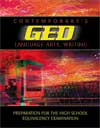|
 |  Contemporary's GED Language Arts, Writing Ellen Carley Frechette
Tim Collins
Writing Your GED Essay
Chapter OutlineStudy the chapter outline below. Use the page numbers below each topic to refer to the corresponding section in Contemporary's GED Language Arts, Writing. When you are finished, go to the Flashcards or choose a different activity or chapter from the menu on the left.
Writing Paragraphs
(See page 254)
-
A paragraph is a group of sentences that develops a central point or main idea.
-
Indicate a new paragraph by indenting its first line.
|
 |  |  | Writing the Introductory Paragraph
(See pages 255–258)
A good introductory paragraph is organized from general to specific. The last sentence, called the thesis statement, previews the body paragraphs by summing up their main ideas. Use your introductory paragraph to do several things: -
state the topic and main idea clearly
-
give an idea of the content and organization
-
arouse the reader’s interest
Remember the following when writing your introduction: -
DO NOT announce your plans.
-
DO NOT apologize or make excuses.
-
DO NOT use empty words, and don't repeat yourself.
-
DO NOT assume that your reader has read the title. State your topic at the beginning.
|
 |  |  | Writing the Concluding Paragraph
(See pages 265 and 266)
The concluding paragraph serves two main purposes: -
to give the essay a sense of completeness
-
to help the reader remember your main point
A good concluding paragraph starts with a rephrasing of your thesis statement from the introduction. It moves from specific (reviewing the main points of your essay) to general (stating the broader importance of the subject). As you write your concluding paragraph, keep these points in mind: -
DO NOT announce your plans.
-
DO NOT apologize for your essay.
-
DO NOT bring up new topics.
|
|
|



 2002 McGraw-Hill Higher Education
2002 McGraw-Hill Higher Education